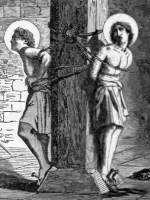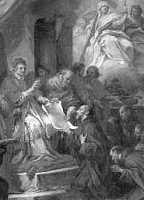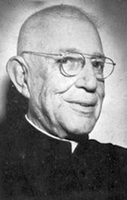St. Leontius
Feastday: June 18
Patron: of Syria
Death: ~70-79
Leontius - Greek martyr killed in Tripoli, Lebanon, or Libya, with Hypatius and Theodolus. Feast day: June 18.
Saints Leontius, Hypatius and Theodolus (Greek: Λεόντιος, Ύπάτιος & Θεόδουλος) were Roman soldiers who, according to Christian tradition, were martyred for their faith.
Leontius was Greek by origin, and served as an officer of the imperial army in the Phoenician city of Tripoli during the reign of Vespasian (70-79). Leontius was distinguished for his bravery and good sense, and the people of Tripoli held him in deep respect because of his virtue.
The emperor appointed the Roman senator Adrian as governor of the Phoenician district, with full powers to hunt out Christians, and in case of their refusal to offer sacrifice to the Roman gods, to give them over to torture and death. On his way to Phoenicia, Adrian received a report that Leontius had turned many away from worshipping the pagan gods. The governor sent the tribune Hypatius with a detachment of soldiers to Tripoli so as to find and arrest the Christian Leontius. Along the way the tribune Hypatius fell seriously ill, and being near death, he saw in a dream an angel, which said: "If you wish to be healed, you and your soldiers should say three times: 'God of Leontius, help me.'".
Opening his eyes Hypatius beheld the angel and said, "I was sent to arrest Leontius, how is it that I should appeal to his God?" At this moment the angel became invisible. Hypatius told his dream to the soldiers, among whom was his friend Theodolus, and all of them together asked for help from the God whom Leontius confessed. Hypatius was immediately healed, to the great joy of his soldiers, but only Theodolus sat aside, pondering the miracle. His soul was filled with love for God, and he told Hypatius to proceed twice as quickly to the city in search of St Leontius.
Upon their arrival in the city, a stranger met them and invited them to his house, where he lavishly hosted the travelers. Learning that their hospitable host was St Leontius, they fell on their knees and asked him to enlighten them with faith in the True God. They were baptized there, and when Leontius prayed over them calling on the Name of the Most Holy Trinity, a luminous cloud overshadowed the newly baptized and poured forth rain. The remaining soldiers in search of their commander arrived in Tripoli, where the governor Adrian had also arrived. Learning what had happened, he order Leontius, Hypatius and Theodolus to be brought to him. After threatening them with torture and death, he demanded that they renounce Christ and offer sacrifice to the Roman gods.
All three firmly confessed their faith in Christ. Hypatius was put under a column and raked with iron claws, and Theodolus was mercilessly beaten with rods. Seeing the steadfastness of these saints, they beheaded them. After torture, they sent Leontius to prison. In the morning he came before the governor. Adrian tried to entice him with honors and rewards, but accomplishing nothing, he gave him over to new tortures. Leontius was suspended head downwards from a pillar with a heavy stone about his neck, but nothing could make him renounce Christ. The governor gave orders to beat the sufferer with rods until he died. They then threw Leontius' body outside the city, but Christians reverently buried it near Tripoli.
The deaths of these martyrs occurred between 70 and 79. The accusation against St. Leontius and his sufferings and death are recorded on tin tablets prepared by the court scribe (commentarisius). These tablets were placed at the grave.
Blessed Osanna Andreasi
Also known as
• Hosanna Andreasi
• Hosanna Andreassi
• Hosanna of Mantua
• Osanna Andreassi
• Osanna of Mantua
Profile
Daughter of Italian nobles Nicolaus and Agnes. Reported to have had a vision of angels, paradise, and the Trinity at age five. Feeling called to religious life, she rejected a marriage arranged by her father, and became a Dominican tertiary at 17; she waited 37 years to complete her vows so she could care for her brothers and sisters after the death of her parents. Mystic who would fall into ecstasies whenever she spoke of God. Visionary who saw images of Christ bearing his cross. Had the pain of the stigmata along with red marks, but no bleeding. Helped the poor and sick, served as spiritual director for many, spent much of her family's considerable fortune to help the unfortunate. Spoke out against decadence, and criticized the aristocracy for a lack of morality. Friend of Blessed Columba of Rieti. A record of her spiritual conversations with Girolamo de Monte Oliveto has survived.
Born
17 January 1449 at Mantua, Italy
Died
1505 of natural causes
Beatified
24 November 1694 by Pope Leo X and Pope Innocent XII (cultus confirmed)
Patronage
school girls
Prayers
O God, giver of all good things, you led Blessed Osanna to prefer the unsearchable riches of Christ above all else and to so teach others. By following her example and teaching may we grow in knowledge of you and faithfully live according to the light of the gospel. We ask this through our Lord Jesus Christ, your Son, who lives and reigns with you and the Holy Spirit, one God, for ever and ever. - General Calendar of the Order of Preachers
Saint Gregory Barbarigo
புனித கிரிகோரி பார்பரிகா
கார்டினல் மற்றும் பெர்கமோ மற்றும் படுவாவின் பிஷப்:
பிறப்பு: செப்டம்பர் 16, 1625
வெனிஸ், வெனிஸ் குடியரசு
இறப்பு: ஜூன் 18, 1697 (வயது 71)
படுவா, வெனிஸ் குடியரசு
ஏற்கும் சமயம்:
ரோமன் கத்தோலிக்க திருச்சபை
நினைவுத் திருநாள்: ஜூன் 18
பெர்கமோ மறைமாவட்டம்
படுவா மறைமாவட்டம்
புனிதர் கிரிகோரியோ ஜியோவானி காஸ்பேர் பார்பரிகோ ஒரு இத்தாலிய ரோமன் கத்தோலிக்க கார்டினல் ஆவார், அவர் பெர்கமோ பிஷப்பாகவும் பின்னர் படுவாவின் பிஷப்பாகவும் பணியாற்றினார். 1689 மற்றும் 1691 ஆம் ஆண்டு போப்பாண்டவர் மாநாடுகளில் அவர் முன்னணியில் இருந்தார், அவரது இராஜதந்திர மற்றும் கல்விசார் தன்மைக்காக தன்னை வேறுபடுத்திக் கொண்டார், ஆனால் அவர் போப்பாண்டவராக மாறவில்லை. அவர் தனது புகழ்பெற்ற கற்றலுக்காகவும், ஆயர் முன்முயற்சிகள் மற்றும் அடிக்கடி திருச்சபை வருகைகள் குறித்தும் கவனமாக கவனம் செலுத்தியதற்காக ஒரு திறமையான போதகராக ஆனார்.
செயின்ட் கிரிகோரி பார்பரிகோ 1625 ஆம் ஆண்டில் மிகவும் பழமையான மற்றும் புகழ்பெற்ற வெனிஸ் குடும்பத்தில் பிறந்தார். ஒரு சிறந்த மாணவர், அவர் ஒரு இராஜதந்திர வாழ்க்கையைத் தழுவி, 1648 இல் வெனிஸ் தூதர் கான்டரினியுடன் மன்ஸ்டர் காங்கிரசுக்குச் சென்றார். பின்னர் அவர் ஒரு பாதிரியார் ஆனார், விரைவில் பெர்காமோவின் முதல் பிஷப்பாக போப் அலெக்சாண்டர் VII ஆல் புனிதப்படுத்தப்பட்டார். பின்னர், அவர் கார்டினல் பதவிக்கு உயர்த்தப்பட்டார், மேலும் படுவா மறைமாவட்டத்தின் மீதும் அதிகாரம் வழங்கினார். அவர் தனது மந்தையை ஆயர் ஞானத்துடனும் ஆழமான புரிதலுடனும் வழிநடத்தினார்.
செயின்ட் கிரிகோரி பார்பரிகோ ட்ரெண்ட் கவுன்சில் வகுத்த சீர்திருத்தங்களை நிறைவேற்றுவதில் இடைவிடாமல் பணியாற்றினார். அவரது முயற்சிகள் மூலம், பெர்கமோ மற்றும் படுவா ஆகிய இரண்டின் கருத்தரங்குகள் கணிசமாக விரிவாக்கப்பட்டன. படுவாவில், அவர் ஒரு நூலகம் மற்றும் ஒரு அச்சகத்தையும் சேர்த்தார். அவர் 1697 இல் இறந்தார். அவரது விருந்து நாள் ஜூன் 18 ஆகும்.
ஆரம்ப கால வாழ்க்கை:
செப்டம்பர் 16, 1625 இல், வெனிஸின் உன்னத குடும்பத்தில் பிறந்த கிரிகோரியோ, வெனிஸ் செனட்டர் ஜியோவானி பிரான்செஸ்கோ பார்பரிகோ மற்றும் லுக்ரேஷியா லயன் (அல்லது லியோனி) ஆகியோரின் மூத்த குழந்தையாக இருந்தார், இவர் மார்ச் 19, 1631 அன்று பிளேக் நோயால் இறந்தார். குழந்தைகளை கவனிப்பதற்காக அவரது தந்தை ஒரு உறவினர் ஃபிரான்செசினா லிப்போமணியை வீட்டிற்கு அழைத்து வந்தார். அவரது ஞானஸ்நான பெயர் கிரிகோரியோ ஜியோவானி காஸ்பரோ.
மற்ற உடன்பிறப்புகள் எலெனா, பியட்ரோ மற்றும் அன்டோனியோ. அவரது கடைசி பெயர் பார்படிகோ மற்றும் பார்படிகோ என்றும் பட்டியலிடப்பட்டுள்ளது. அவர் கார்டினல் மார்கன்டோனியோ பார்பரிகோவின் (1686) உறவினராகவும், கார்டினல் ஜியோவானி ஃபிரான்செஸ்கோ பார்பரிகோவின் (1719) மாமாவாகவும் இருந்தார். அவரது தந்தை அவருக்கு தத்துவம் மற்றும் கணிதத்தில் கற்பித்தார், அதே நேரத்தில் போதகர்கள் அவருக்கு லத்தீன் மற்றும் கிரேக்கம் கற்பித்தனர்; மேலும் அவர் இசையின் அடிப்படைகளையும் பெற்றார்.
புரோகிதம் & எபிஸ்கோபசி
பார்பரிகோ செப்டம்பர் 25, 1655 அன்று நியதி மற்றும் சிவில் சட்டம் ஆகிய இரண்டிலும் முனைவர் பட்டம் பெற்றார், மேலும் வெனிஸின் தேசபக்தரான கியான் பிரான்செஸ்கோ மொரோசினியால் 1655 டிசம்பர் 21 அன்று ஒரு பாதிரியாராக நியமிக்கப்பட்டார். அவர் 1656 பிப்ரவரி இறுதியில் ரோம் புறப்பட்டார், போப் அலெக்சாண்டர் VII அழைத்தார், அவர் அவரை போப்பாண்டவர் சேவையில் தொடங்கினார். அவர் பரிசுத்தத்தின் உள்நாட்டு மதகுருவாக பெயரிடப்பட்டார். 21 ஏப்ரல் 1656 அன்று, Fr. பார்பரிகோ நீதி மற்றும் கிரேஸின் அப்போஸ்தலிக் கையொப்பத்தின் தீர்ப்பாயங்களின் வாக்காளராக நியமிக்கப்பட்டார். 965 ஆம் ஆண்டு ஜூன் 9 ஆம் தேதி, படுவாவின் கதீட்ரல் அத்தியாயத்தில் அவருக்கு குடியிருப்பு தேவை இல்லாமல் ஒரு நியமனம் வழங்கப்பட்டது. 1656 ஆம் ஆண்டில், போப் அலெக்சாண்டர் VII இன் வேண்டுகோளின் பேரில், பிளேக் நோயால் பாதிக்கப்பட்ட டிராஸ்டீவர் பகுதியில் ரோமானியர்களுக்கு அவர் உதவிகளை ஏற்பாடு செய்தார்.
அவர் பெர்கமோவின் வெற்றிகரமான பிஷப்பாக இருந்தார், மேலும் போப் அலெக்சாண்டர் 1660 இல் அவரை கார்டினலேட்டுக்கு உயர்த்தினார். 1664 இல் அவர் படுவாவின் பிஷப்பாக நியமிக்கப்பட்டார். தனது எபிஸ்கோபல் கடமைகளில் நுழைந்த அவர், செயிண்ட் சார்லஸ் போரோமியோவில் தன்னை மாதிரியாகக் காட்ட முயன்றார். அவர் ட்ரெண்ட் கவுன்சிலின் பணிக்கு வலுவான ஆதரவாளராக இருந்தார். அவர் படுவா மற்றும் பெர்கமோவின் கருத்தரங்குகளை பெரிதாக்கினார் மற்றும் படுவாவில் ஒரு நூலகம் மற்றும் அச்சகத்தை சேர்த்தார்.
கிரிகோரியோ பார்பரிகோ ஜூலை 6, 1761 அன்று போப் கிளெமென்ட் XIII ஆல் அழிக்கப்பட்டு கிட்டத்தட்ட 189 ஆண்டுகளுக்குப் பிறகு போப் ஜான் XXIII ஆல் 26 மே 1960 இல் நியமனம் செய்யப்பட்டார். போப் ஜான் XXIII ஆல் நியமிக்கப்பட்ட முதல் துறவி, ஜான் XXIII புனித கிரிகோரியுடன் நெருங்கிய உறவை உணர்ந்ததாகக் கூறப்படுகிறது. பார்பரிகோ மற்றும் அவரது பணியில் வாழ்நாள் முழுவதும் பக்தி வைத்திருந்தார்.
1962 ஆம் ஆண்டின் பொது ரோமானிய நாட்காட்டியில், ஜூன் 17 அன்று அவருக்கு மூன்றாம் வகுப்பு விருந்து உண்டு. இப்போதெல்லாம், அவரது விருந்து ஜூன் 18 அன்று கொண்டாடப்படுகிறது.
Also known as
• Gregory Bardardico
• Gregorio Barbarigo
• Gregorio Giovanni Gasparo Barbarigo
• Gregory Lewis Barbadigo
Profile
Son of a Venetian senator. Educated at the University of Padua. Civil and canon lawyer. Worked on the negotiations for the Peace of Westphalia that ended the Thirty Years' War on 24 October 1648; one of his co-workers was archbishop Fabio Chigi, the future Pope Alexander VII. Ordained on 21 December 1655. Domestic prelate to Pope Alexander VII. Referendary of the Tribunals of the Apostolic Signature of Justice and of Grace. Bishop of Bergamo, Italy on 9 July 1657. Created cardinal on 5 April 1660. Bishop of Padua, Italy on 24 March 1664. Part of the conclave of 1667 that chose Pope Clement IX. Part of the conclave of 1676 that chose Blessed Pope Innocent XI. Supervised Catholic teaching in Rome, Italy for three years. Part of the conclave of 1689 that chose Pope Alexander VIII. Part of the conclave of 1691 that chose Pope Innocent XII. Noted as a distinguished churchman and leading citizen whose charities were on a princely scale. Worked for unity of the Latin and Orthodox Churches.
Born
16 September 1625 at Venice, Italy as Gregorio Giovanni Gasparo Barbarigo
Died
• 18 June 1697 at Padua, Italy of natural causes
• buried in the cathedral of Padua
Beatified
6 July 1771 by Pope Clement XIV
Canonized
26 May 1960 by Blessed Pope John XXIII
Saint Elizabeth of Schönau
ஸ்ஷோனவின் புனித எலிசபெத் (Elisabeth of Schönau) துறவி
பிறப்பு 1128 பிங்கன், ரைன்
இறப்பு 18 ஜூன் 1164 ஸ்ஷோனவ்
சிறுவயதிலிருந்தே இறைவனிடத்தில் மிகவும் பக்தி கொண்ட இவர், தம் 12ஆம் வயதிலேயே ஸ்ஷோனவ் என்ற ஊரிலிருந்த புனித ஆசீர்வாதப்பர் சபையில் சேர்ந்தார். தனது 18 ஆம் வயதில் வார்த்தைப்பாடுகளை கொடுத்து துறவியானார். குழந்தை பருவத்திலிருந்தே தன்னை இறைவனிடம் அர்ப்பணித்து வாழ்ந்தார். இவர் பிறந்த ஊரிலிருந்த அனைவரிடத்திலும், மிகவும் அன்பாகவும், இரக்கமுள்ளவராகவும் இருந்தார்.
இளம் வயதிலேயே துறவியான இவர் மன நோய்க்கு ஆளாக்கப்பட்டார். இதனால் மிகவும் பயத்துடனேயே எப்போதும் வாழ்ந்து வந்தார். 1152 ஆம் ஆண்டிலிருந்து எலிசபெத், இறைவன் தரும் அருளை காட்சியாக பெற்றார். அவ்வாறு பலமுறை இறைவனின் காட்சியை பெறும்போது, ஒருநாள் மிகுந்த அச்சம் இவரை ஆட்கொண்டது, அன்று அவரை சுற்றி பேரோளி ஒன்று வீசியது. அப்போது அவர் மிகச் சரளமாக, தடுமாற்றம் இல்லாமல் அன்னிய மொழியான இத்தாலி மொழியை பேசினார். இம்மொழியை அவர் எப்போதும் கற்றுக்கொண்டதே இல்லை. எலிசபெத்தின் உடன்பிறந்த அண்ணன் ஏக்பர்ட்(Egbert Schönau) துறவியாக இருந்தார். இவர் எலிசபெத் கடவுளிடமிருந்து பெற்ற ஒவ்வொரு தரிசனத்தையும் தன் கைப்பட எழுதி வைத்துள்ளார். தான் இறைவனிடம் இருந்து பெற்ற தரிசனங்களின் வழியாக இவர் ஏராளமான மக்களுக்கு நன்மை செய்து, வாழ்வில் ஒளியேற்றியுள்ளார்
Also known as
• Elizabeth of Sconauge
• Elisabeth of...
Profile
Born to the German nobility. Raised and educated in Schönau Benedictine abbey near Bingen, Germany from age 12. Elizabeth came to see the abbey as home, and took vows as a Benedictine nun in 1147. Friend of Saint Hildegard von Bingen. Abbess at Schonau from 1157 until her death.
In 1152 she began receiving ecstacies and visions of Jesus and Mary, received the gift of prophecy, and suffered the assaults of demonic forces. With the help of her brother Egbert, a monk and abbot, she wrote three volumes describing her visions. The periods in ecstacies weakened her already fragile health.
Born
1126 in Bingen, Germany
Died
• 18 June 1164 at Bingen, Germany of natural causes
• buried in the church of Saint Florin at the Schönau abbey
• most relics were destroyed by Swedish forces in 1632
• remaining relics enshrined in the parish church in Schönau
Canonized
• never formally canonized, but popular devotion went on for centuries
• added to the Roman Martyrology in 1584 by Pope Gregory XIII
Representation
Benedctine nun with a book
Patronage
against temptations
Blessed Euphemia of Altenmünster
Also known as
Eufemia
Profile
Daughter of Count Berthold and Sophie of Andechs; sister of the Saint Mechtildis of Edelstetten. Benedictine nun. Abbess of Altomünster abbey in Dachau, Upper Bavaria (in modern Germany), expanding its property and population, and leading by personal piety and devotion to the Benedictine Rule.
Born
12th century Bavaria, Germany
Died
• 18 June c.1180 in Altomünster abbey in Dachau, Upper Bavaria (in modern Germany) of natural causes
• buried in her family crypt in Diessen am Ammersee, Bavaria, Germany
Saint Marcellian
Also known as
Marcellianus
Profile
Son of Saint Tranquillinus of Rome who raised him a pagan before his own conversion. Twin brother of Saint Mark. Convert to Christianity. May have been a deacon. Imprisoned for his faith during the persecutions of Maximian Herculeus. Visited in prison by Saint Sebastian who encouraged him not to give in. Martyr.
Died
• nailed to a post and pierced with a lance in 286
• buried near the Catacomb of Saint Domitilla
• grave re-discovered in 1902
Blessed Marina of Spoleto
Profile
Member of the Canonesses Regular of Saint Augustine, taking the name Marina in honour of Mary, Star of the Sea. Founded the monastery of San Matteo in 1265, a house devoted to strict observation of the Augustinian rule. Led a life dedicated to prayer.
Born
early 13th century Spoleto, Italy as Vallarina Petruccini
Died
• 18 June 1300
• body found incorrupt when relics translated in 1471
• body found incorrupt when relics translated in 1548
• body found incorrupt when relics translated in 1639
Saint Mark
Also known as
Marcus
Profile
Son of Saint Tranquillinus of Rome who raised him a pagan before his own conversion. Twin brother of Saint Marcellian. Convert to Christianity. May have been a deacon. Imprisoned for his faith during the persecutions of Maximian Herculeus. Visited in prison by Saint Sebastian who encouraged him not to give in. Martyr.
Died
• nailed to a post and pierced with a lance in 286
• buried near the Catacomb of Saint Domitilla
• grave re-discovered in 1902
Saint Equizio of Telese
Also known as
Equizio the Deacon
Profile
Deacon to Saint Palerio of Telese.
Died
• buried in the church of San Palerio at an unknown point
• grave re-discovered following a vision in 1167
• relics re-discovered in 1712 when the old church was being demolished
• relics enshrined under the high altar of the church of Saint John the Baptist on 5 March 1713
Saint Abraham of Clermont
Profile
While on a journey from Syria to Egypt to learn from the desert monks, he was kidnapped by thieves and kept captive for five years. He eventually escaped and by land and sea made his way to Gaul where he settled as a hermit near Clermont in the Auvergne region. His reputation for holiness spread, and he attracted so many would be students that he had to build a monastery for them. Miracle worker.
Born
5th century Syria
Died
472 of natural causes
Saint Marina of Bithynia
Profile
Hermitess in 8th century Bithynia (in modern Turkey), wearing a monk's habit. The desert fathers of the time knew her, wrote of her, and considered her a holy woman.
Died
• c.750 of natural causes
• relics translated to the church of San Marina in Venice, Italy in 1230
• some relics translated to the church of San Marina in Parish, France
Saint Calogerus the Anchorite
Also known as
• Calogero the Anchorite
• Calogerus the Anchoret
Profile
Fifth century evangelist on the island of Lipari, Italy. Lived his last 35 years as a hermit near Girgenti, Sicily. Noted exorcist.
Born
Greece
Died
c.486 of natural causes
Hermits of Karden
Profile
A father (Felicio) and his two sons (Simplicio and Potentino)who became pilgrim to various European holy places, and then hermits at Karden (modern Treis-Karden, Germany).
Born
Aquitaine (in modern France)
Died
relics transferred to places in the Eifel region of western Germany at some point prior to 930
Canonized
12 August 1908 by Pope Pius X (cultus confirmation)
Saint Calogero of Sicily
Also known as
Calogerus
Profile
Hermit with the gift of healing by prayer.
Born
c.466 in Chalcedon, Thrace
Died
c.561 at Monte Cronios, Sciacca, Sicily
Saint Amandus of Bordeaux
Also known as
Amand, Amantius, Amatius
Profile
Bishop of Bordeaux, France c.404. Brought Saint Paulinus of Nola to the faith.
Born
latter 4th century
Died
• c.431 of natural events
• buried at the church of San Severino
Saint Osanna of Northumbria
Profile
Princess of Northumbria (in modern England) who became a nun.
Born
7th century England
Died
• 8th century England of natural causes
• buried in Howden, Northumberland, England
• miracles reported at her tomb
Saint Calogerus of Fragalata
Profile
Monk, receiving the habit in Rome. Abbot. Driven into North Africa by Arian Vandals with Saint Demetrius and Saint Gregory. Settled, preached in Fragalata, Sicily.
Died
at Fragalata, Sicily
Patronage
Fragalata, Sicily
Saint Alena of Dilbeek
Also known as
• Alena of Forest
• Elena
Profile
Raised in a pagan family, Alena converted and was baptised in secret. Murdered while trying to secretly go to Mass.
Born
near Brussels, Belgium
Died
martyred c.640
Blessed Peter Sanchez
Profile
Mercedarian. In Algiers in North Africa he ransomed 50 Christians enslaved and put to hard labour by Muslims.
Died
1503 in Valensia, Spain of natural causes
Saint Demetrius of Fragalata
Profile
Fifth century archdeacon. Driven into North Africa by Arian Vandals with Saint Gregory and Saint Calogerus. Settled, preached in Fragalata, Sicily.
Died
at Fragalata, Sicily
Patronage
Fragalata, Sicily
Saint Gregory of Fragalata
Profile
Fifth century bishop. Driven into North Africa by Arian Vandals with Saint Demetrius and Saint Calogerus. Settled, preached in Fragalata, Sicily.
Died
at Fragalata, Sicily
Patronage
Fragalata, Sicily
Saint Fortunatus the Philosopher
Profile
Bishop driven from the north of Italy by the Lombards, settling near Chelles, France. Known for the depth of both his education and his personal piety.
Died
c.569 of natural causes
Saint Edith of Aylesbury
Also known as
Edith of Bicester
Profile
Born a princess, the daughter of King Penda of Merca, sister of Saint Edburga of Bicester. Nun at Aylesbury.
Died
c.650
Saint Etherius of Nicomedia
Also known as
Aetherius of Nicomedia
Profile
Martyred in the persecutions of Diocletian.
Died
304 in Nicomedia (in modern Turkey)
Saint Guy of Baume
Profile
Benedictine monk at Baume with Saint Berno of Cluny. Abbot at Baume. Resigned the position c.940 to retire as a hermit near Fayen-Bresse.
Died
c.940
Blessed Jerome of Vallumbrosa
Profile
Benedictine Vallumbrosan monk. Hermit who lived 35 years on bread and water.
Died
1135 of natural causes
Saint Cyriacus of Málaga
Profile
Martyred in the persecutions of Diocletian.
Died
stoned to death in 305 in Málaga, Spain
Saint Elpidius of Brioude
Also known as
Elpida, Elpidia, Helpidius
Profile
Fourth-century martyr.
Died
Brioude, France
Saint Paula of Málaga
Profile
Martyred in the persecutions of Diocletian.
Died
stoned to death in 305 in Málaga, Spain
Saint Osmanna of Jouarre
Also known as
Osanna
Profile
Nun at Jouarre, France.
Died
c.700 of natural causes
Saint Arcontius of Brioude
Also known as
Arconce, Arcons
Profile
Fourth-century confessor in Brioude, France.
Saint Marina of Alexandria
Also known as
Maria, Marianus
Profile
Martyr.
Died
Alexandria, Egypt
Saint Gerland
Profile
Thirteenth century knight.
Died
relics at Caltagirone, Sicily
Saint Erasmo
Profile
Hermit. May have been a monk or anchorite, but no details have survived.
Saint Colman mac Mici
Profile
No details about him have survived.
Martyrs of Ravenna
Profile
A group of four Christians martyred together. We have no details but their names – Crispin, Cruciatus, Emilius and Felix
Died
Ravenna, Italy, date unknown
Martyrs of Rome
Profile
Three Christians martyred together. We have no details but their names – Cyriacus, Paul and Thomas
Died
Rome, Italy, date unknown
Martyrs of Tripoli
Profile
Three imperial Roman soldiers, at last two of them recent converts, who were imprisoned, tortured and executed for their faith. Martyrs - Hypatius, Leontius and Theodulus.
Born
Greek
Died
c.135 at Tripoli, Phoenicia (in modern Lebanon)
Also celebrated but no entry yet
• Baithan of Dunleer
• Cadwgan of Bangor
• Furudran of Dunleer
• Hermann Floreffe
• Hosanna Howden














































